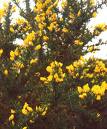
Above, a thicket of furze (gorse)
Parish reports in the Statistical Accounts reveal how important the availability of fuel was to the Scottish peasant. Cheap fuel was considered an immense advantage for some parishes; its lack caused almost unbelievable hardship in other parishes.
Peat moss was the principal fuel in most parishes of the Highlands and the Islands. However, the labour involved in getting peat took up a disproportionate amount of time. It would not be unusual, for example, for a family to spend most of their summer collecting peat. This was exacerbated by the poor transportation network.
Where peat was not available, for example in many parishes in Perthshire, the poor used brushwood, furse (gorse), and broom. One minister wrote: In summer, the peasantry burn only broom and furze, which they frequently have for the cutting at all times for a price. Note that the laird owned the land on which they lived. If there were trees, cutting them would be prohibited. Obviously from this comment in the Statistical Accounts, he also charged the peasants for less substantial fuel. In some parishes, lands that were out of tillage soon became over-run with broom and that became a source of fuel close to home; in some cases, lands were deliberately sown with broom. Another fuel source was culm. This was a mixture of coal dust and clay that was made into balls to burn on fires. It was frequently mixed with cow dung. Other fuel substances were turf and manure.
Coal was the preferred fuel. In places where it was accessible and relatively cheap (e.g., Fife, the Forth valley), ministers expressed its availability as a benefit. Whereas in other parishes, particularly in Perthshire, the absence of coal was a strongly felt grievance. Here are two such comments.
One great disadvantage, under which the inhabitants of this parish labour, is their distance from fuel. The works from which coal is generally procured, are distant about 20 miles, and the roads far from good. Half the summer is spent in bringing home as much coal as is necessary for the winter's supply. Peats are procured from the higher grounds, but not without great labour and waste of time.
Peat and turf, broom and furze were formerly the only fuel used in this district. To these, coal is now added. They justly reckon it cheaper, as it is more easily procured, than any other kind of fuel. In summer, the farmers sometimes go 30 or 40 miles to the coal pits in Fife where it is purchased at a comparatively low price.

Above, a thicket of broom
Obviously, the lack of fuel had to lead to health hazards. Winters were cold and fuel was needed, first, for cooking the food. Bear in mind, too, that women and children went shoeless. Even getting the fuel could impact health. Some fuel was so distant that the peasants would take an entire day to get to the source. Then, they'd lie out in the open all night before being able to load their horses and return.
Even those parishes that had easy access to coal had reason for unhappiness - the tax on any coal transported by water, a tax that applied to Scottish subjects but not to the English. Some ministers equated the presence of the coal tax to high emigration rates. Here's one such comment: Nine-tenths of the diseases, which afflict the poorer part of the people, are those of debility and chiefly arise from cold, it can hardly be wondered at, that the [coal] tax has been productive of considerable discontent and much emigration.
The hated coal tax was repealed in 1793. Also, during this period, the establishment of the turnpike road system alleviated many of the problems facing parishes that were distant from the coal fields. But, prior to this, the difficulties in obtaining fuel were a significant source of health problems and unhappiness for many people in Scotland. Here's a comment that describes their life.
The day-light, during the winter, is spent by many of the women and children in gathering sticks, furze, or broom, for fuel, and the evening in warming their shivering limbs before the scanty fire which this produces.
It's hard enough for us to fathom what life would be like in a cold winter in a damp house with little or no fire. Now, add to that picture, a starving family with possibly no food other than potatoes, yet lacking the fuel with which to cook them.
Sources
Steven, Maisie (1995). Parish Life in 18th Century Scotland: A review of the old Statistical Accounts Glasgow: Scottish Cultural Press